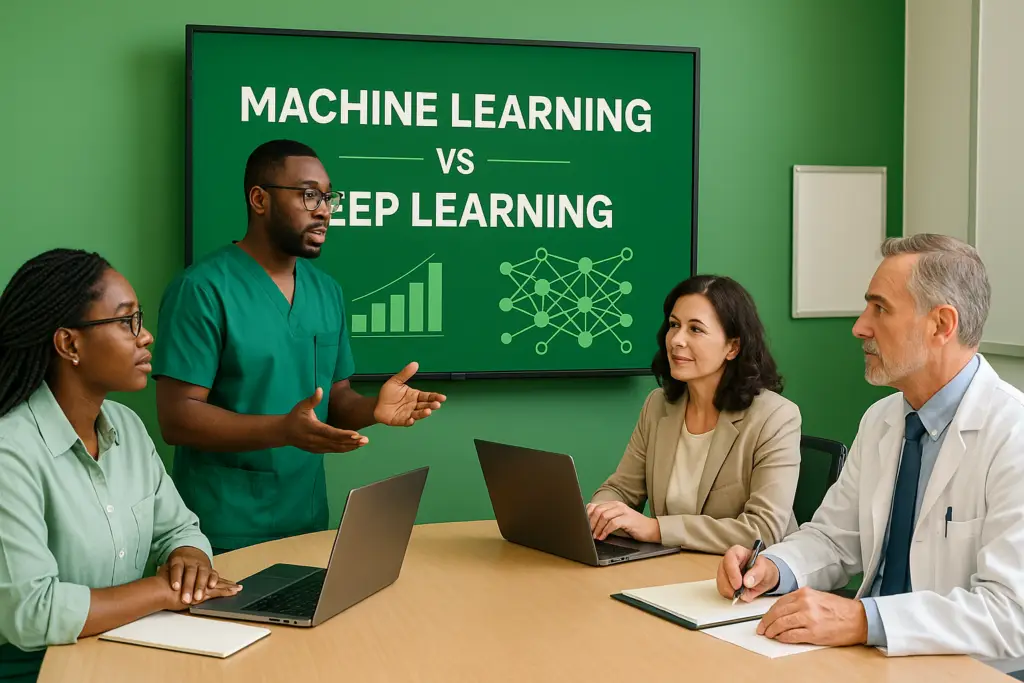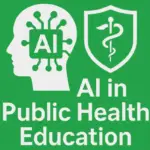Applications in Public Health

Published on AI Public Health Update | aipublichealthupdate.com
Introduction
Artificial Intelligence (AI) has become a transformative force across numerous sectors, with public health being no exception. Within the broad field of AI, machine learning and deep learning have emerged as powerful tools that are revolutionizing how we approach public health challenges—from disease surveillance to treatment optimization and health resource allocation.
While these terms are often used interchangeably, machine learning and deep learning represent distinct approaches with different capabilities, requirements, and applications. Understanding these differences is crucial for public health professionals seeking to leverage these technologies effectively.
This article aims to demystify these technologies, explaining their core differences through accessible analogies and highlighting their specific applications in public health. Whether you’re a public health practitioner, policymaker, or researcher, this knowledge will help you navigate the rapidly evolving landscape of AI in healthcare.
Machine Learning: The Specialized Consultant
Machine learning algorithms operate like specialized consultants who need your guidance to get started. You must identify which aspects of your data are relevant (feature engineering) and choose appropriate models for specific problems. Traditional ML approaches such as Random Forests, Support Vector Machines, and Gradient Boosting work efficiently with structured data and deliver excellent results when properly configured. They require less computational power and can work with smaller datasets, making them practical for many applications where transparency and interpretability are crucial.
Think of machine learning like teaching a dog specific tricks through repetition and rewards. You show the dog examples, provide feedback, and it learns to recognize patterns. Traditional machine learning algorithms require human experts to identify and extract the important features from data, similar to how you might need to show a dog exactly what to look for when fetching a specific toy.
Public Health Example: Predicting Disease Outbreaks
Public health departments use traditional machine learning algorithms to predict disease outbreaks based on historical data. For instance, a Random Forest model might analyze factors like seasonal patterns, demographic information, and environmental conditions to forecast flu outbreaks. Epidemiologists select relevant features (variables) that might influence disease spread, and the algorithm identifies patterns that humans might miss. This approach requires expert knowledge to select appropriate variables but can work effectively with limited historical data available to many local health departments.
Key Applications of Machine Learning in Public Health
- Risk Assessment Models: Machine learning algorithms like logistic regression models analyze patient data to predict disease risks and treatment outcomes. The Framingham Risk Score, which assesses cardiovascular disease risk, represents an early application of statistical modeling in healthcare predates modern ML but is now frequently re-implemented or compared with ML models for cardiovascular-risk prediction.
- Resource Allocation: Health departments use machine learning to optimize resource distribution during public health emergencies. These models can predict where supplies, staff, or vaccines will be most needed based on demographic and historical utilization data.
- Medication Adherence: Support Vector Machines (SVMs) can identify patients who might struggle with medication adherence based on socioeconomic factors, medical history, and past behavior patterns, allowing for targeted interventions to improve outcomes.
- Environmental Health Monitoring: Decision trees and ensemble methods analyze environmental data to identify potential health hazards, such as predicting neighborhoods at risk for lead exposure or water contamination.
“The power of traditional machine learning in public health lies in its ability to work with limited, structured data while providing clear explanations for its predictions—a critical feature when decisions affect public policy and resource allocation.”
Deep Learning: The End-to-End Solution
Deep learning functions as an end-to-end solution that eliminates much of the manual preprocessing. Neural networks automatically extract meaningful patterns from raw data through multiple processing layers that progressively refine their understanding—similar to how information flows through departments in an organization before reaching a final decision. This approach excels with unstructured data like images, natural language, and time series, enabling previously impossible applications.
If machine learning is like training a dog, deep learning is more like raising a child who learns to recognize objects, sounds, and concepts naturally through exposure and experience. Neural networks with multiple layers (hence “deep”) automatically discover the important features without human guidance, similar to how children learn to distinguish cats from dogs without explicit instructions about whiskers or barking.
Public Health Example: Medical Imaging Analysis
Deep learning has revolutionized medical imaging analysis in ways that directly impact public health. Convolutional Neural Networks (CNNs) have reached radiologist-level performance in several validation studies, though results vary with data quality and clinical setting.. In resource-limited settings, these systems can provide screening capabilities where specialist physicians are unavailable. During the COVID-19 pandemic, deep learning models were developed and, in early evaluations, showed 82–98 % classification accuracy for COVID-19 pneumonia on CT images, supporting faster triage in pilot deployments.
Key Applications of Deep Learning in Public Health
- Disease Detection from Medical Imaging: Neural networks analyze medical images to detect conditions like diabetic retinopathy, tuberculosis, or skin cancer, enabling early intervention and screening at scale in underserved populations.
- Epidemic Forecasting: Recurrent Neural Networks (RNNs) and transformers analyze complex temporal patterns in disease spread, incorporating unstructured data like social media posts, mobility patterns, and climate variables to predict disease transmission with greater accuracy.
- Drug Discovery: Deep learning models like AlphaFold predict protein structures and potential drug interactions, dramatically accelerating the development of new treatments for emerging public health threats.
- Health Monitoring: Wearable devices combined with deep learning algorithms continuously stream physiologic data that DL algorithms can use to flag early deterioration in pilot studies; large-scale clinical validation is ongoing.
- Natural Language Processing for Public Health Surveillance: Deep learning models analyze social media, news reports, and electronic health records to detect disease outbreaks or adverse drug reactions before they’re reported through traditional surveillance systems.
“Deep learning’s ability to process vast amounts of unstructured data—from medical images to social media posts—has opened new frontiers in public health surveillance and intervention, particularly in detecting subtle patterns that human analysts might miss.”
Comparing Machine Learning and Deep Learning in Public Health
| Aspect | Machine Learning | Deep Learning |
| Data Requirements | Can work with smaller datasets; hundreds to thousands of examples | Requires large datasets; typically thousands to millions of examples |
| Feature Engineering | Requires manual feature selection and engineering by domain experts | Automatically extracts features from raw data |
| Computational Resources | Can run on standard computers; less resource-intensive | Often requires specialized hardware (GPUs/TPUs) and significant computing power |
| Interpretability | Generally more interpretable; easier to explain predictions | Often operates as a “black box”; harder to explain specific decisions |
| Best Use Cases in Public Health | Structured clinical data analysis, risk prediction models, resource allocation | Medical imaging, genomic analysis, complex pattern recognition in epidemiology |
| Implementation Complexity | Relatively straightforward to implement and maintain | Requires specialized expertise to develop and maintain |
The choice between machine learning and deep learning in public health applications depends on various factors including the nature of available data, the specific problem being addressed, resource constraints, and the need for interpretability. Many successful public health initiatives employ both approaches, using machine learning where transparency and explanation are paramount, and deep learning where dealing with complex, unstructured data is critical.
Large Language Models: Advanced Deep Learning Systems
Current Large Language Models (LLMs) like ChatGPT, Gemini, Claude, and others firmly fall under the deep learning category. These systems are built on specialized neural network architectures called Transformers, which represent the cutting edge of deep learning technology. They employ numerous processing layers (sometimes hundreds) that allow them to learn complex patterns in language without explicit feature engineering—a defining characteristic of deep learning.
The development of these LLMs exemplifies deep learning in its most advanced form. They require enormous computational resources during training (often thousands of GPUs running for weeks), massive datasets (hundreds of billions of words), and result in models with billions or even trillions of parameters. This scale enables them to capture nuanced linguistic patterns, contextual relationships, and even some reasoning capabilities that would be impossible with traditional machine learning techniques.
Public Health Applications of LLMs
LLMs are finding various applications in public health, including:
- Health Literacy: LLMs can translate complex medical information into easily understandable content for diverse populations, improving health literacy and communication.
- Clinical Decision Support: These models are being tested as summarization and suggestion tools for clinicians; current prototypes require strict human oversight and have not yet cleared regulatory approval.
- Public Health Communication: During health emergencies, LLMs help craft clear, consistent messaging adapted to different audiences and languages.
- Medical Literature Analysis: LLMs can rapidly synthesize findings across thousands of research papers, helping public health officials stay current with emerging evidence.
“While LLMs represent remarkable achievements in deep learning, their responsible deployment in public health requires careful consideration of ethical issues, including potential biases, privacy concerns, and the need for human oversight in critical decision-making processes.”
Future Directions: Hybrid Approaches in Public Health
The future of AI in public health likely lies in hybrid approaches that combine the strengths of both machine learning and deep learning. These hybrid systems aim to balance the interpretability and efficiency of traditional machine learning with the pattern recognition power of deep learning.
Emerging approaches include:
- Explainable AI (XAI): Research focused on making deep learning models more transparent and interpretable, which is crucial for healthcare applications where understanding the rationale behind predictions is essential.
- Federated Learning: Allowing models to learn from decentralized data without sharing sensitive information, addressing privacy concerns in public health surveillance.
- Few-Shot Learning: Developing models that can learn from limited examples, particularly valuable in rare disease detection or emerging health threats where data is scarce.
- Multimodal Learning: Combining different data types (clinical notes, images, genomic data) to develop more comprehensive understanding of health conditions and social determinants of health.
These advancements promise to enhance our ability to address complex public health challenges, from pandemic preparedness to reducing health disparities and improving population health management.
Conclusion
Machine learning and deep learning represent powerful but distinct approaches within artificial intelligence that are transforming public health practice. Traditional machine learning offers interpretability, efficiency with smaller datasets, and works well with structured data—making it suitable for many evidence-based public health applications where transparency is crucial.
Deep learning, with its ability to automatically extract features from complex, unstructured data, has enabled breakthroughs in medical imaging, disease surveillance, and health monitoring that were previously unattainable. Large Language Models represent the cutting edge of deep learning, offering new capabilities in health communication and knowledge synthesis.
For public health professionals, understanding the strengths, limitations, and appropriate applications of each approach is essential for effectively leveraging these technologies to improve population health outcomes. As these technologies continue to evolve, hybrid approaches that combine the best aspects of both paradigms will likely provide the most powerful tools for addressing complex public health challenges.
The successful integration of these AI technologies into public health practice will require not just technical expertise, but thoughtful consideration of ethical implications, equity concerns, and the development of appropriate governance frameworks to ensure these powerful tools serve the public good.
